"At the specific written request of the addressee"
On January 8, 1943, due to military demands on shipping space, the Postal Service announced that "No parcels shall be accepted for dispatch to A.P.O.'s (Army Post Office) outside the continental United States unless they contain such articles only as are being sent at the specific written request of the addressee, approved by the battalion or similar unit commander of the address." [1] The policy was slightly amended in March 1943 so that small parcels, usually for items like eye glasses, fountain pens, and watches not exceeding 8 ounces, could be mailed via first class without written requests from the addressee. [2] The requirement that a soldier’s commander approve each written request was onerous, met with severe criticism, and ultimately rescinded in May 1943. [3] However, the individual mailing a package to a soldier overseas was required to present the recipient-soldier’s written request and the envelope it was mailed in to a postal employee so that they could be marked to prevent reuse. [4]
An example of this process is shown below in a letter written by Private First Class Thomas B. Harper III from France to his parents:
. . . please send me, chocolate bars, jam, cake (fruit keeps, yours should too), pastry, nuts, saltines, canned fruit, canned food (pork & beans-sardines[,] etc.), socks (heavy wool), hankies, stationery & air mail envelopes, candy and a scarf.
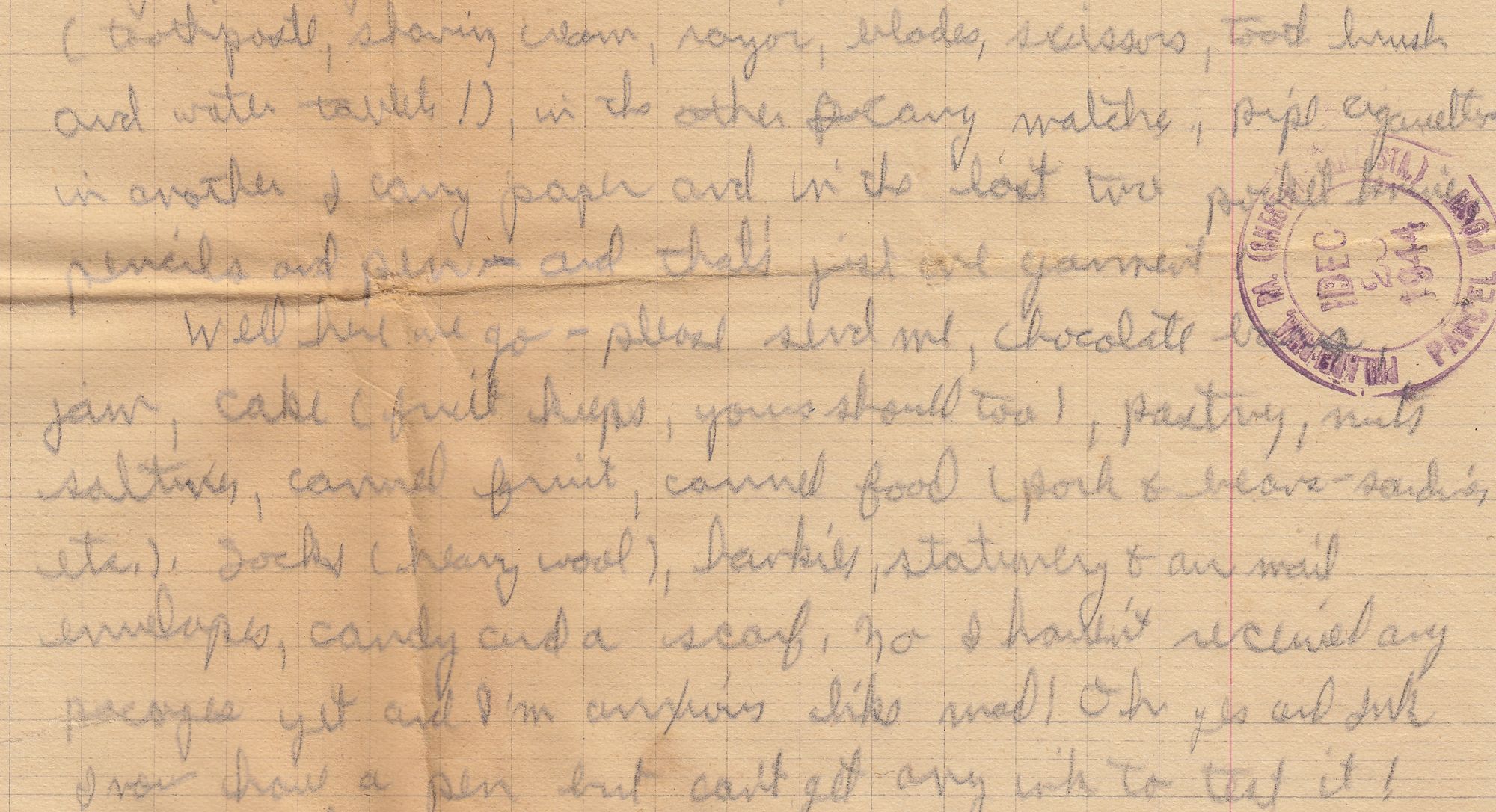
As a result of this Postal Service policy letters sent by soldiers overseas, or memoirs that include descriptions of letters sent by those soldiers, allow for interesting historical analysis of the types of items soldiers requested be sent to them on the front lines. Using a sample of memoirs and letters sent by thirteen soldiers in the 100th Infantry Division during their time in combat revealed several commonalities.
Data
The raw data for my research, with citations, is below.
Soldiers in the Sample Who Requested:
- Food - 100% (13/13)
- Writing Supplies (pens, ink, stamps, stationary, etc.) - 54% (7/13)
- Clothing items - 46% (6/13)
- Candles - 38% (5/13)
- Books - 15% (2/13)
Number of Requests that Contain **:
- Food - 74% (39/53)
- Writing Supplies - 19% (10/53)
- Candles - 16% (8/53)
- Clothing - 13% (7/53)
- Books - .04% (2/53)
**Note that each request could contain multiple items.
Please click on each thumbnail image to enlarge.
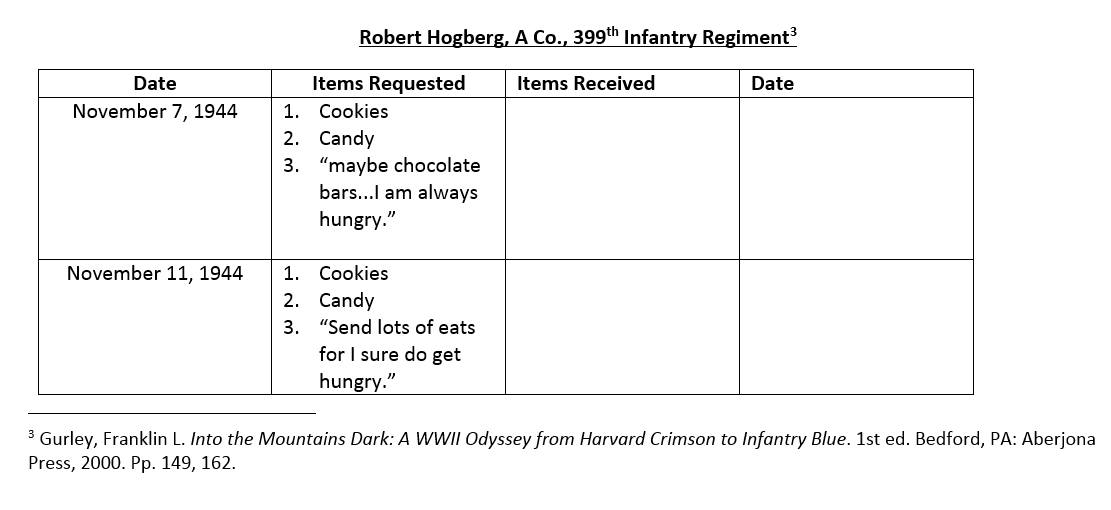
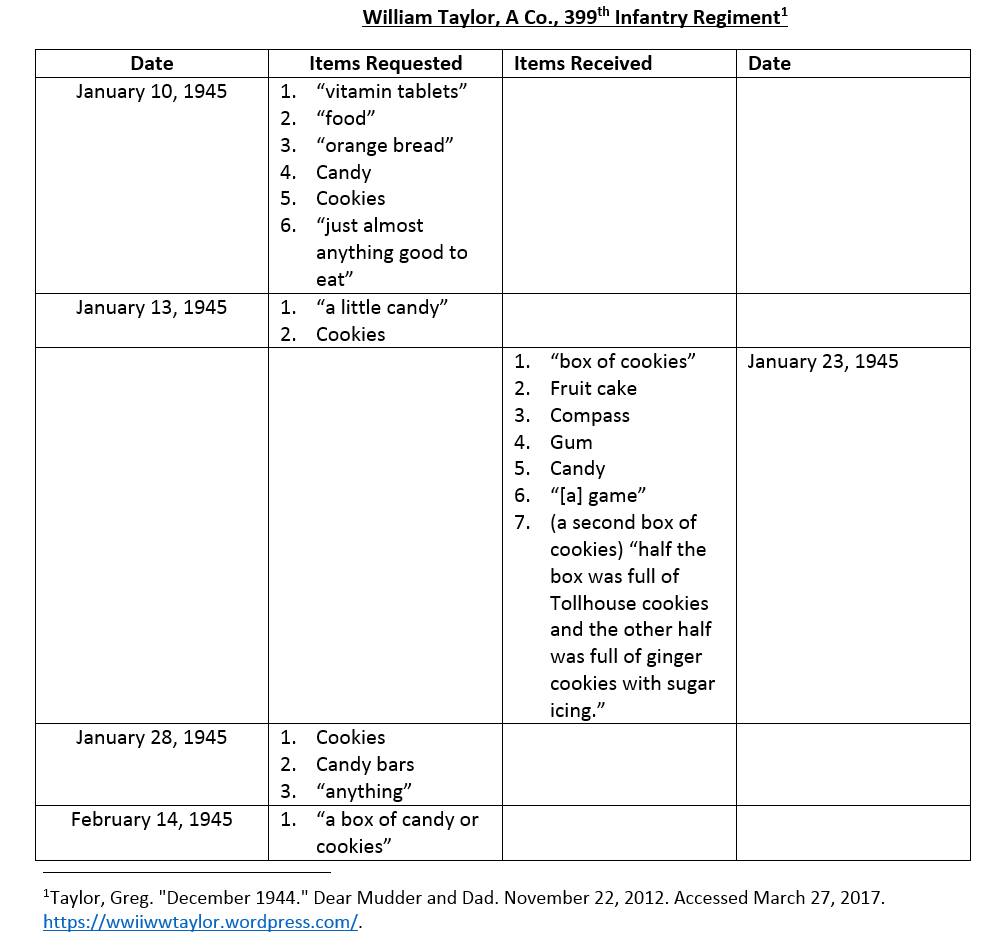
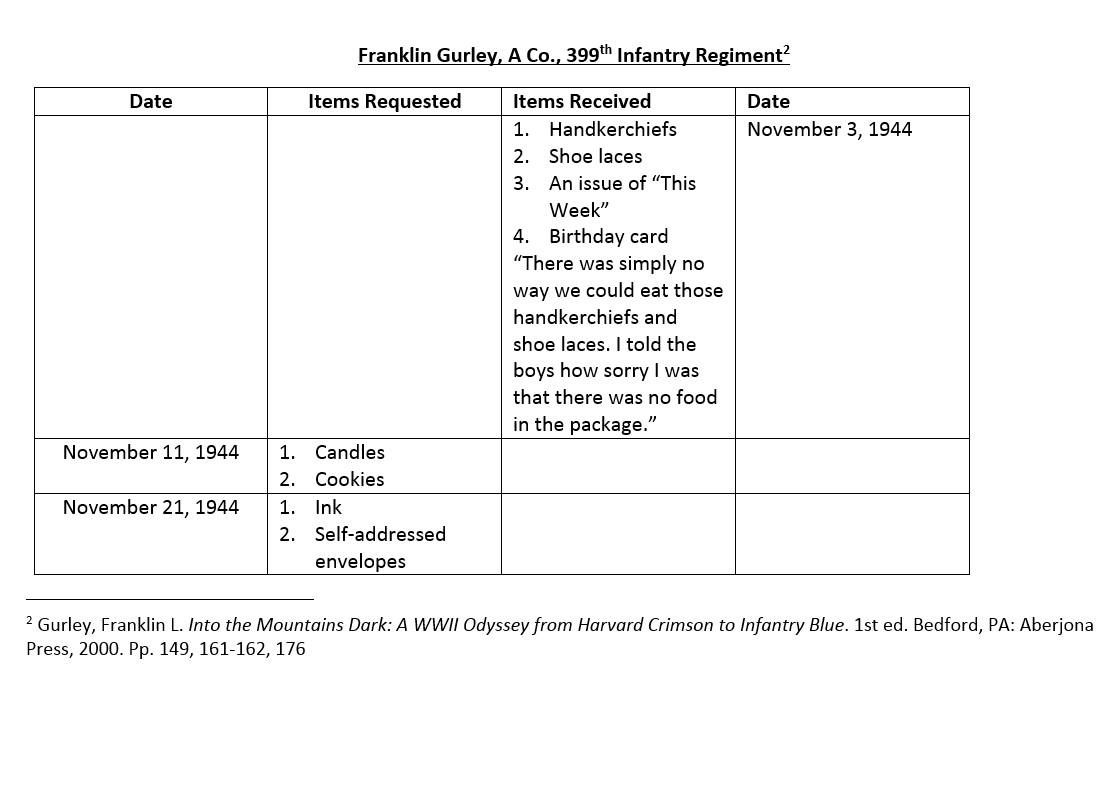
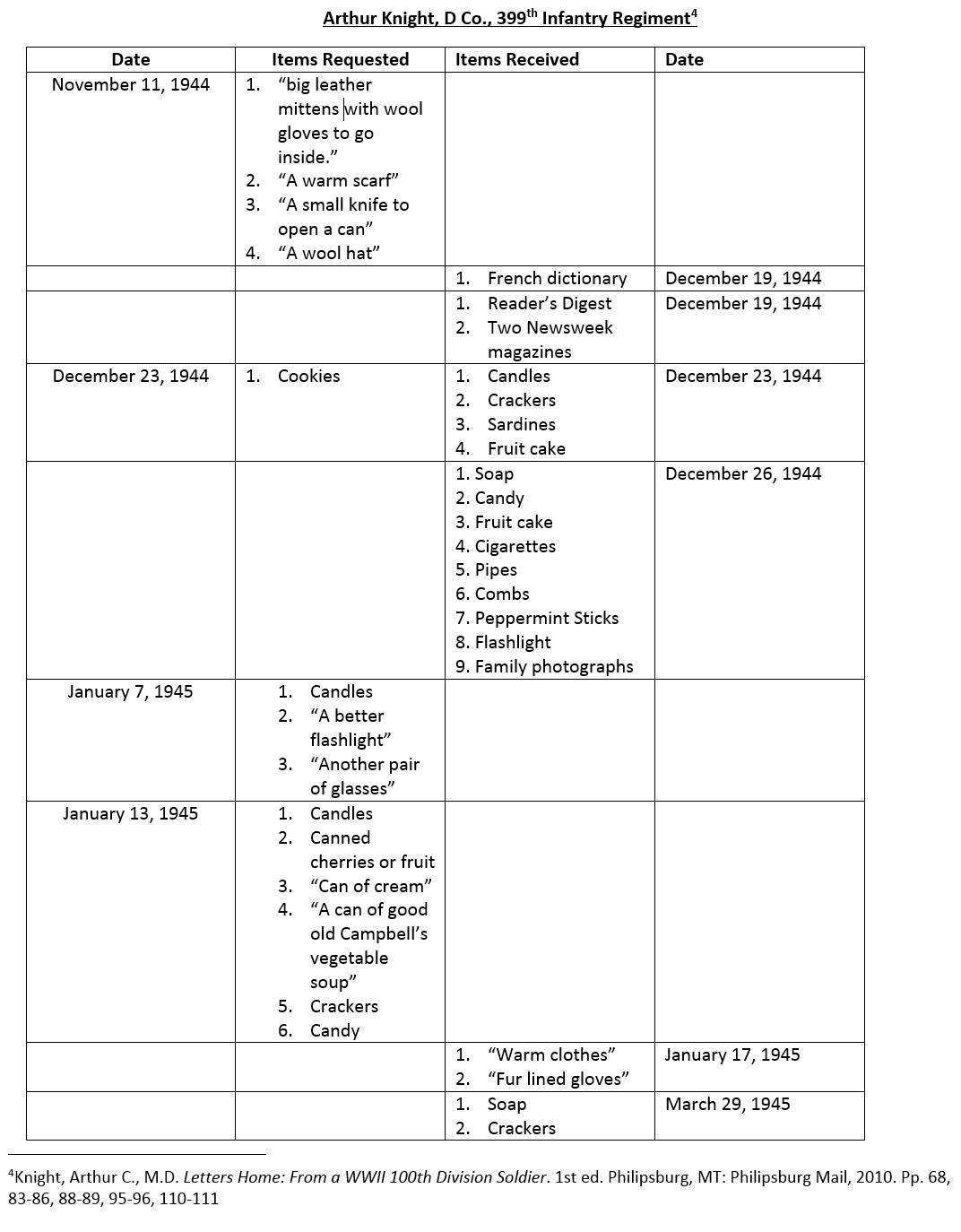
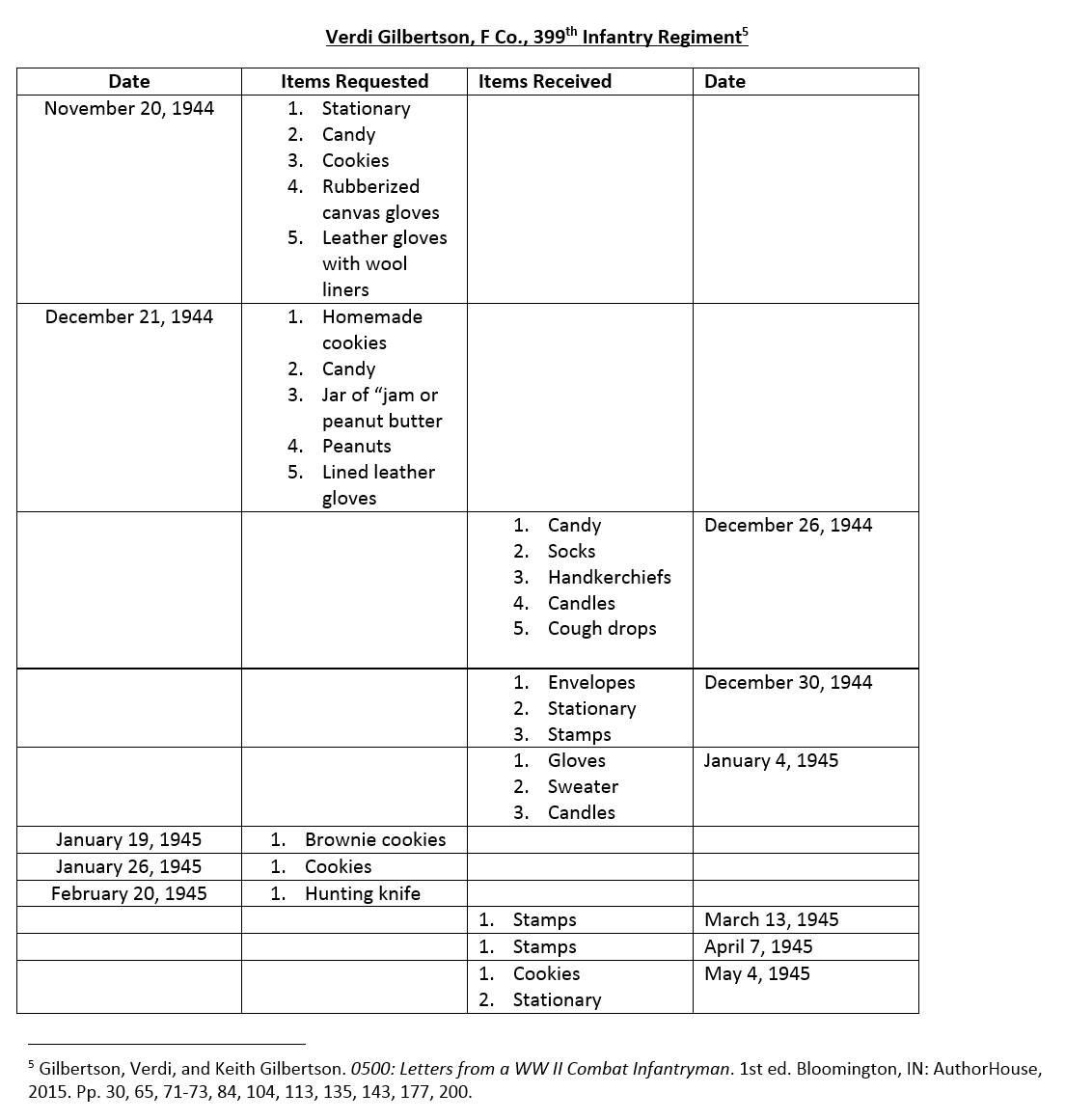
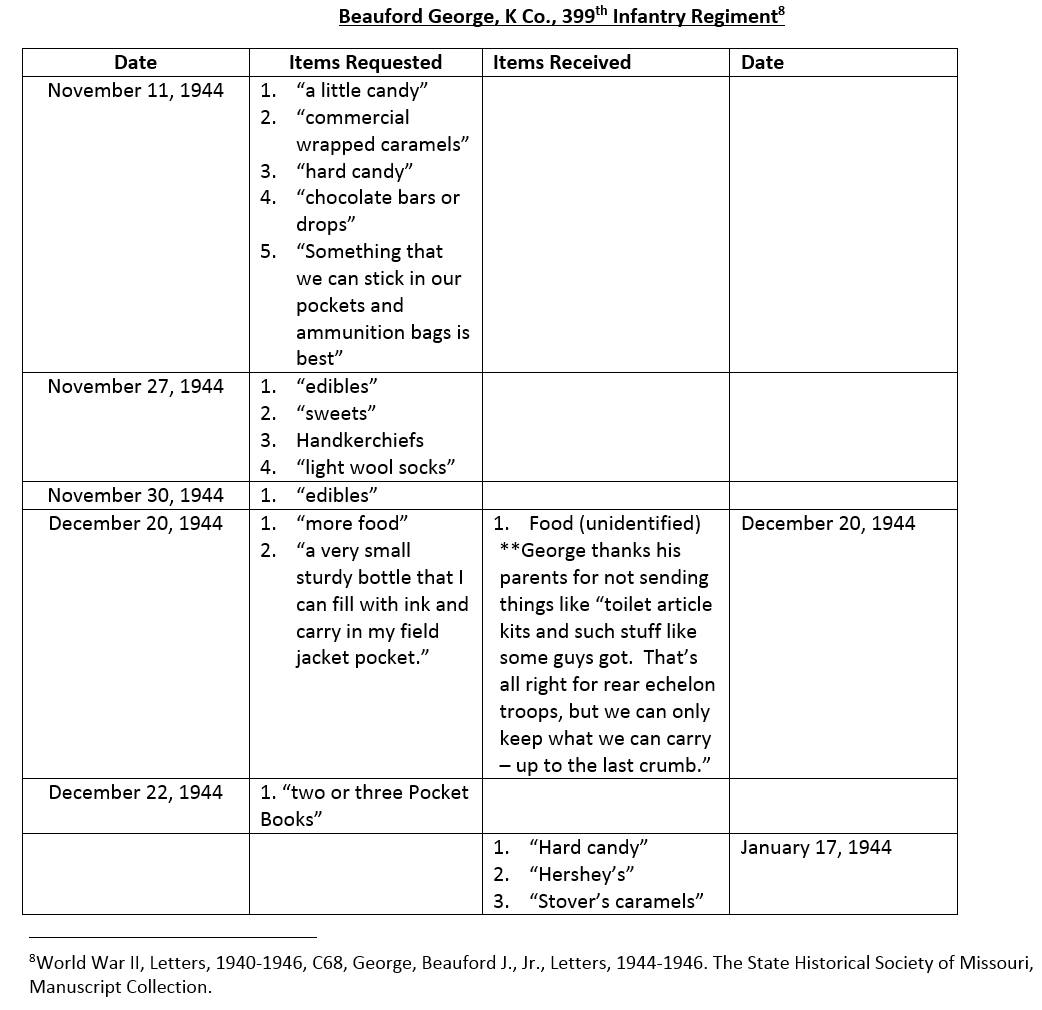
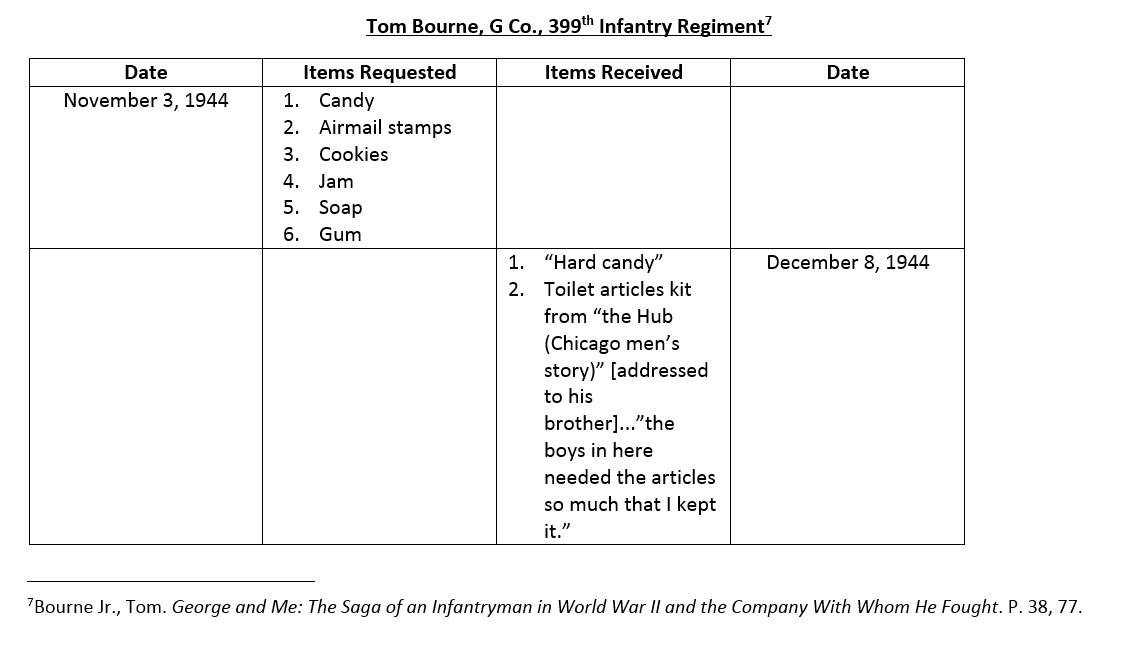
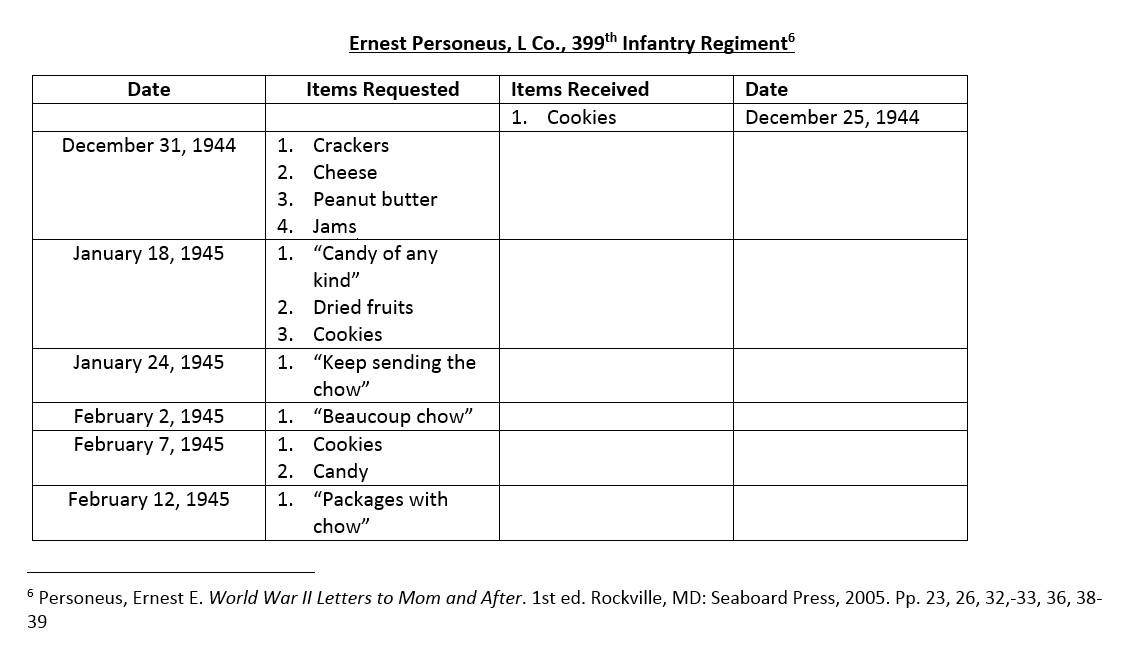

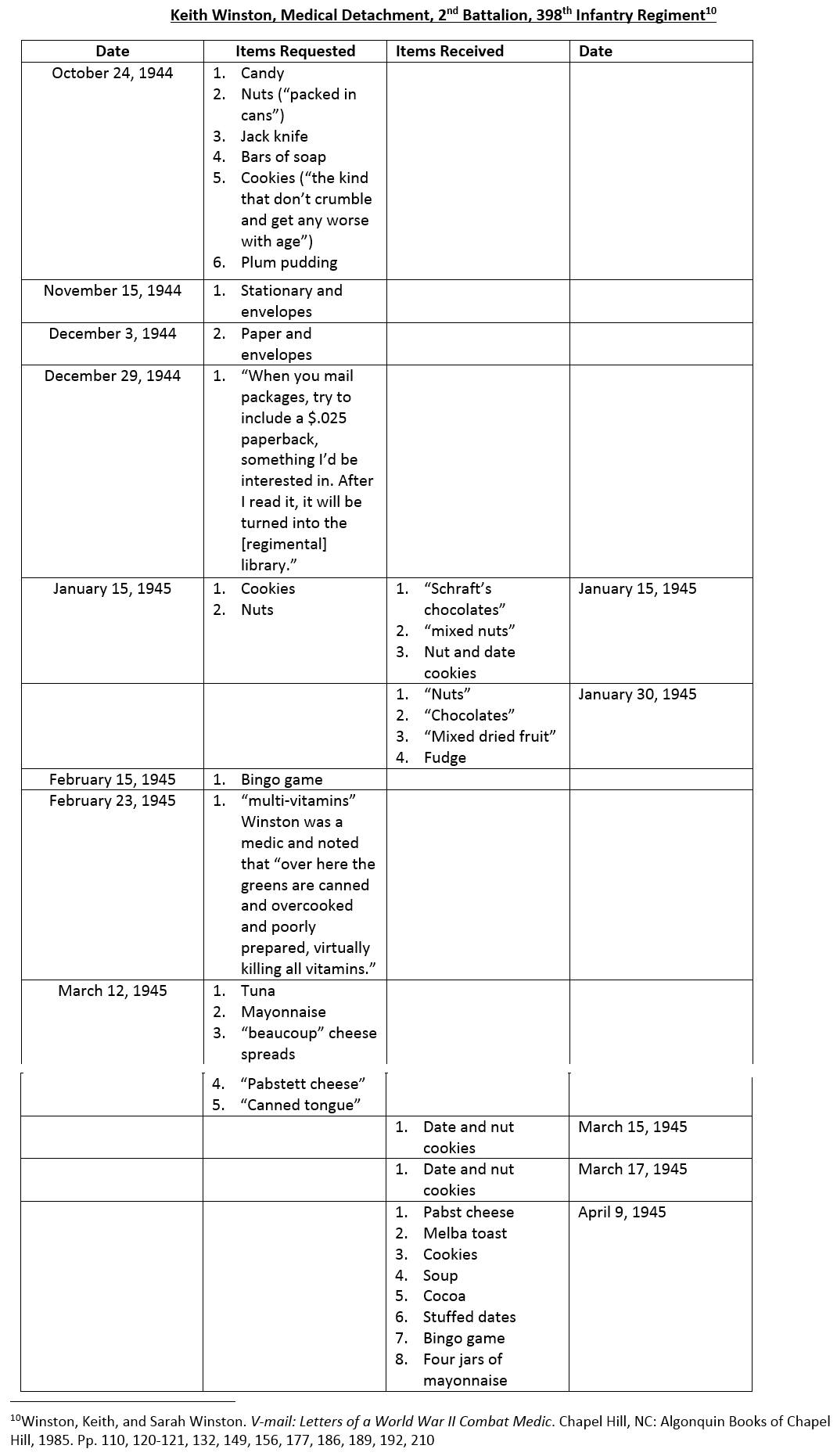
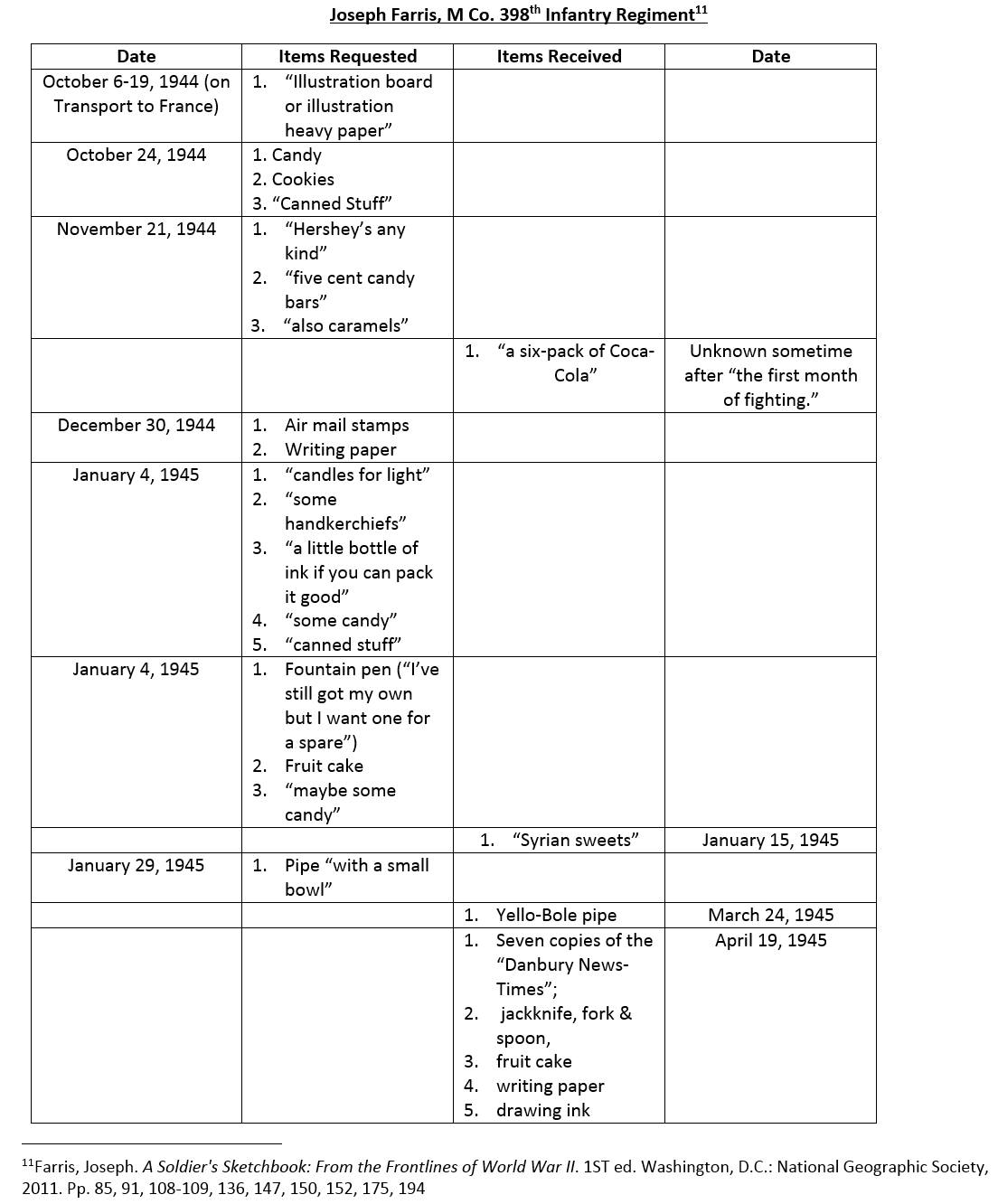
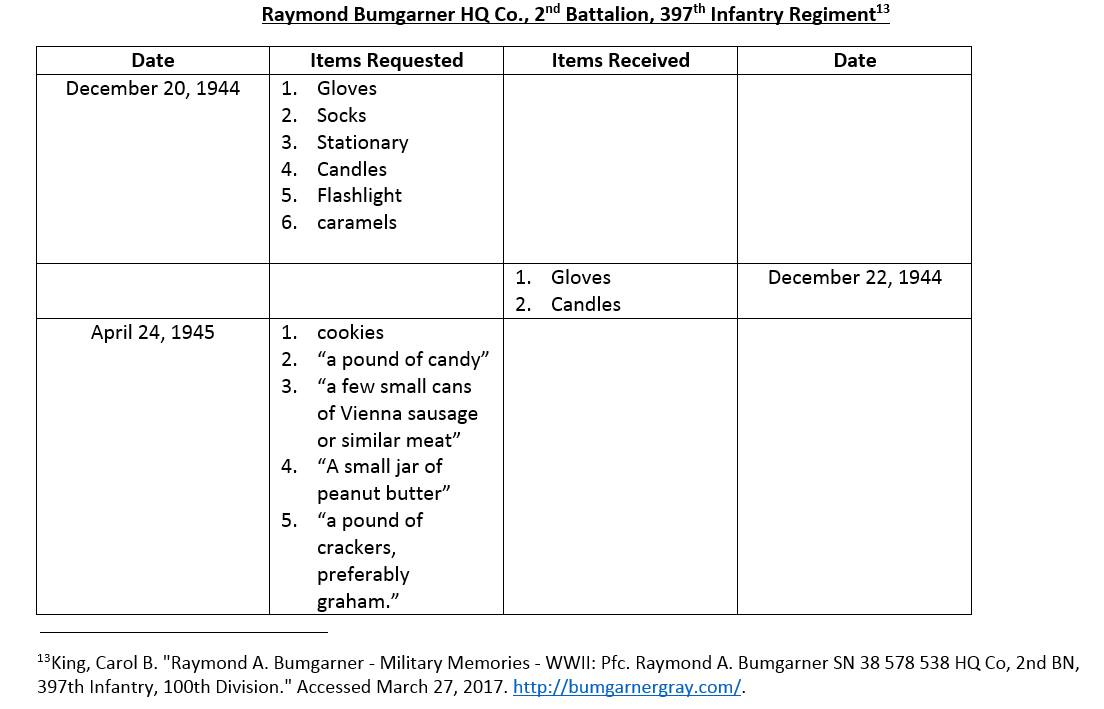
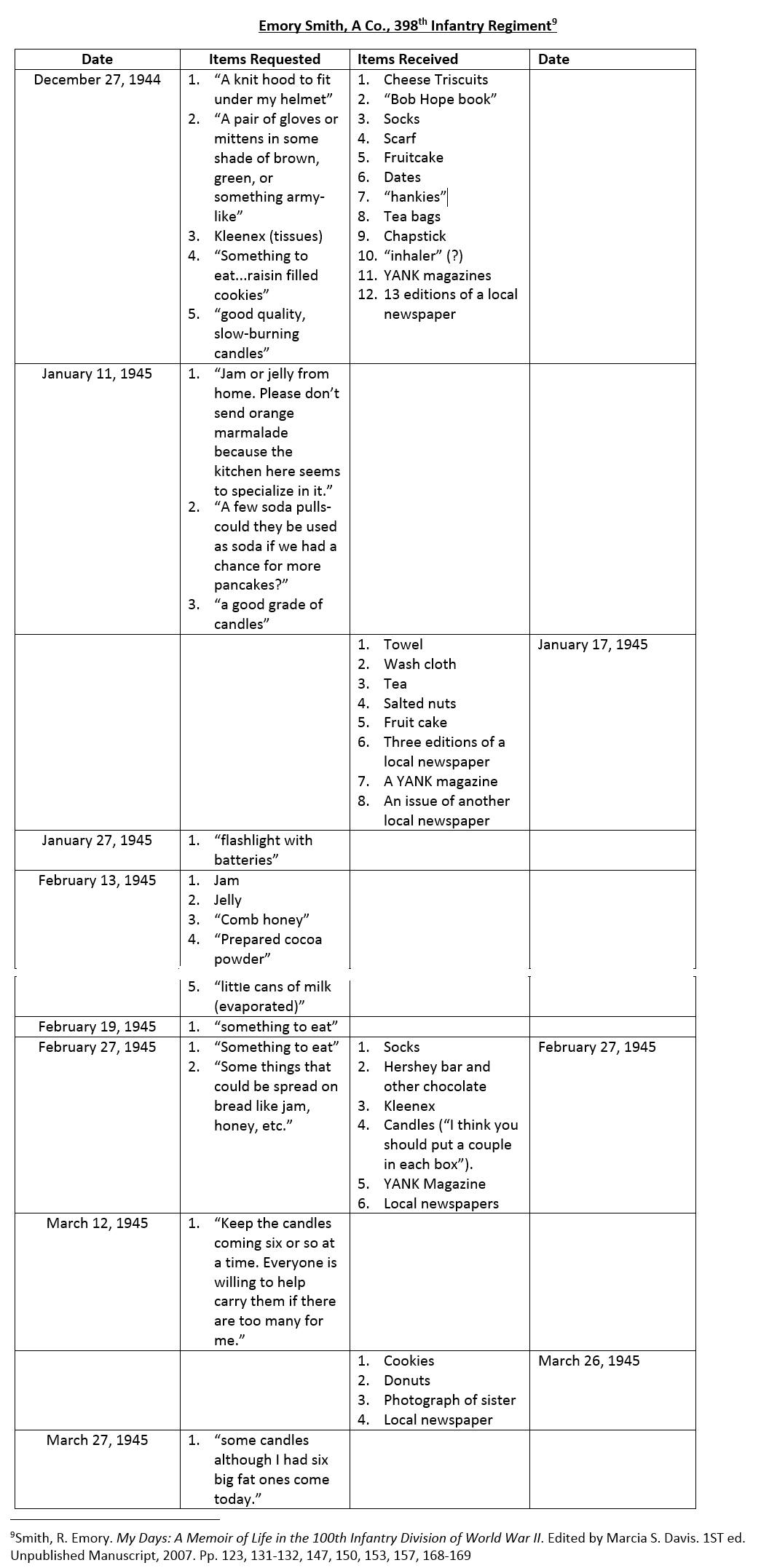
Findings
Food was by far the most often requested item, in part because it was practical, but more importantly, because it was different than the bland and monotonous Army K and C rations the troops were fed everyday. [5] Most soldiers appear to have shared the sentiments of Robert "Hoggie" Hogberg (A Company, 399th Infantry Regiment) who told his parents in a letter "Send lots of eats for I sure do get hungry." [6] Many different items were requested, from cans of evaporated milk to candy bars.
Food was so desired that when a package did arrive and its contents were not edible, the recipient's morale could suffer. When Franklin Gurley (A Company, 399th Infantry Regiment) received a package that contained handkerchiefs and shoe laces he apologized to his buddies because "there was simply no way we could eat those handkerchiefs and shoe laces." [7]
Candles were also frequently requested. Of the clothing items requested, gloves appear to be the most common (requested by 5 of the 13 soldiers surveyed).
Weapons were notable omissions. No firearms were requested, and only one weapon, a hunting knife, was requested but does not appear to have been received prior to Victory in Europe (V-E) Day. [8]
Some of the more interesting requests were a "bingo game" by a medic in the 2nd Battalion, 398th Infantry Regiment, and "vitamin tablets" by a rifleman in A Company, 399th Infantry Regiment. [9] The most interesting item received was a six pack of Cola-Cola. [10]
Footnotes
[1] "Restrictions on Overseas Shipments to Army Personnel." The Postal Bulletin LXIV, No. 18539 (January 8, 1943): 1, accessed October 15, 2019, http://www.uspostalbulletins.com/PDF/Vol64_Issue18539_19430108.pdf
[2] “Mail for Army Personnel Overseas.” The Postal Bulletin LXIV, No. 18566 (March 12, 1943): 1, accessed October 15, 2019, http://www.uspostalbulletins.com/PDF/Vol64_Issue18566_19430312.pdf
[3] “Modifications of Restrictions Regarding Mail for Army Personnel Overseas.” The Postal Bulletin LXIV, No. 18597 (May 21, 1943): 1, accessed October 15, 2019, http://www.uspostalbulletins.com/PDF/Vol64_Issue18597_19430521.pdf
[4] Postmaster General, J.M. Donaldson, comp. A Wartime History of the Post Office Department, World War II 1939-1945 (Washington, D.C.: U.S. Government Historical Reports on War Administration, 1951), 87.
[5] William Shinji Tsuchida, Wear It Proudly: Letters by William Shinji Tsuchida (Berkeley, CA: Univ. of California Press, 1947), 39.
[6] Franklin L. Gurley, Into the Mountains Dark: A WWII Odyssey from Harvard Crimson to Infantry Blue (Bedford, PA: Aberjona Press, 2000), 162.
[7] Ibid., 149.
[8] Verdi Gilbertson, 0500: Letters from a WWII Combat Infantryman (Bloomington, IN: AuthorHouse, 2015), 135.
[9] Keith Winston and Sarah Winston. V-mail: Letters of a World War II Combat Medic (Chapel Hill, NC: Algonquin Books of Chapel Hill, 1985), 176; Greg Taylor. "The World War II Letters of William Wellington Taylor, Jr." Letter 170- January 10, 1945. December 21, 2009, accessed October 10, 2019, https://taylorletters.blogspot.com/2009/12/letter-170-january-10-1945.html.
[10] Joseph Farris, A Soldier’s Sketchbook: From the Front Lines of World War II (Washington, D.C.: National Geographic, 2011), 91. There is at least one other example of a soldier receiving bottles of soda in combat. Oscar Starnes, a machine gunner in the 103rd Division received two bottles of RC Cola from relatives in Asheville, North Carolina. "Starnes, Oscar; Co A 409th," 103d Infantry Division World War II Association, The University of Southern Mississippi, accessed October 15, 2019, http://103divwwii.usm.edu/assets/starnes%2C-oscar-e.pdf.